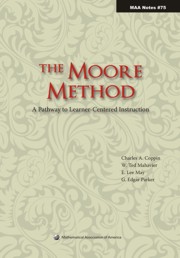Book contents
- Frontmatter
- Contents
- Dedication
- Acknowledgements
- 1 Introduction
- 2 Moore's Moore Method
- 3 What is the Moore Method?
- 4 On Culture
- 5 Development and Selection of Materials
- 6 In the Classroom
- 7 Grading
- 8 Why Use the Moore Method?
- 9 Evaluation and Assessment: Effectiveness of the Method
- 10 Frequently Asked Questions
- Appendices
- About the Authors
- References
- Index
5 - Development and Selection of Materials
- Frontmatter
- Contents
- Dedication
- Acknowledgements
- 1 Introduction
- 2 Moore's Moore Method
- 3 What is the Moore Method?
- 4 On Culture
- 5 Development and Selection of Materials
- 6 In the Classroom
- 7 Grading
- 8 Why Use the Moore Method?
- 9 Evaluation and Assessment: Effectiveness of the Method
- 10 Frequently Asked Questions
- Appendices
- About the Authors
- References
- Index
Summary
“That student is taught the best who is told the least.”
R. L. MooreThis chapter addresses the generation of materials to be used to support Moore Method teaching. Development and usage of materials by the prospective user is treated from various perspectives, including
guidelines for writing your own problem sequences,
adapting textbook treatments,
adapting pre-existing Moore Method course notes,
modifying materials to fit the realities of a particular class,
addressing learning-theory issues, and
obtaining support when using another's notes.
These perspectives illustrate principles that may guide the construction of problem sets, resolve the question of authoring notes or adapting pre-existing notes, and provide sources for course notes that have been written for use in Moore Method classes other than your own.
The essays will likely offer the greatest benefit if read in the order presented, especially for the reader entertaining thoughts about using the Moore Method for the first time. May's essay is both highly practical and succinct in its outlook. Mahavier deals, in some detail, with making the decision whether to author notes or use a pre-existing problem sequence. He then segues into guidelines for penning materials. Coppin focuses exclusively on authoring one's own notes, addressing issues from learning theory and illustrating how course notes can address these theories directly. Parker writes from the viewpoint of generating course notes, then adapting them consequent to classroom dynamics.
Information
- Type
- Chapter
- Information
- The Moore MethodA Pathway to Learner-Centered Instruction, pp. 45 - 68Publisher: Mathematical Association of AmericaPrint publication year: 2009
